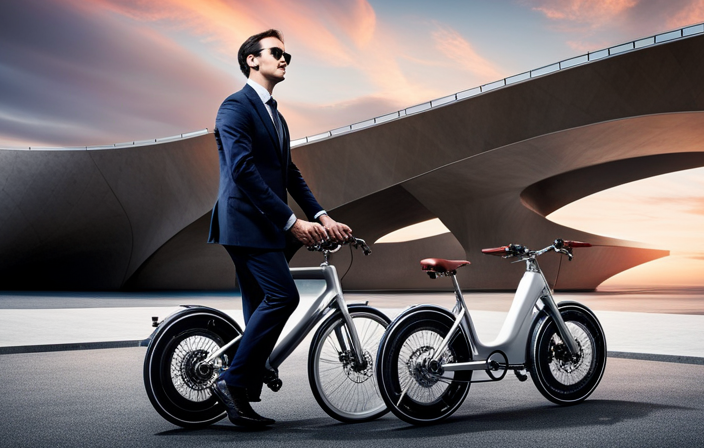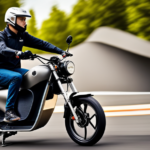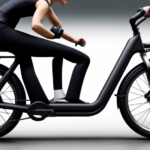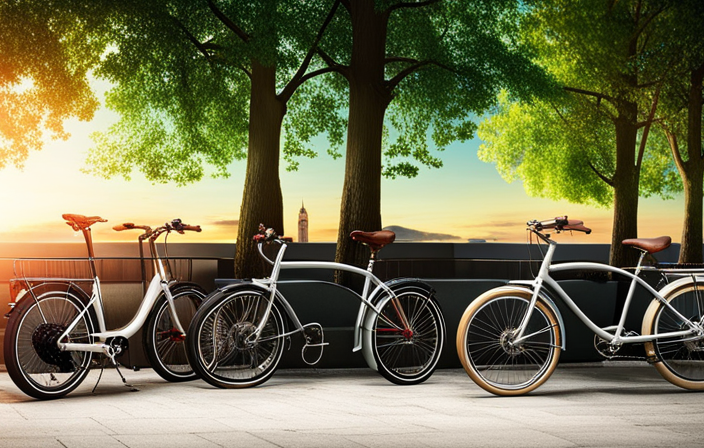Ever thought about what’s inside an electric bike’s lithium battery? It’s more than meets the eye. Discover how this key component unleashes the strength and stamina of your reliable two-wheeler.
In this article, we will delve into the intricacies of Ah, exploring its impact on battery capacity, weight, and the ever-evolving world of battery technology.
So, strap on your helmet and join us on this enlightening journey through the world of Ah in electric bike batteries.
Key Takeaways
- Ah rating determines the energy storage and recharge frequency of an e-bike lithium battery.
- Higher Ah rating allows for longer rides without needing to recharge frequently.
- Understanding the Ah rating helps estimate the range and duration of e-bike rides.
- Factors such as terrain, rider weight, and chosen assist level also affect the range and duration of e-bike rides, alongside the Ah rating.
The Basics of Battery Capacity
To understand the basics of battery capacity, you need to know how it affects the performance of your electric bike. Battery capacity is measured in ampere-hours (Ah) and it represents the amount of energy the battery can store.
The higher the Ah rating, the longer your electric bike can run on a single charge. A higher capacity battery will allow you to ride for longer distances without needing to recharge.
It’s important to consider your biking needs when choosing the battery capacity for your electric bike. If you plan to use your bike for longer rides or have a higher power motor, a battery with a higher Ah rating would be more suitable.
Understanding battery capacity is crucial in maximizing the performance and range of your electric bike.
Importance of Battery Capacity in Electric Bikes
Make sure you understand how important the capacity of your battery is when riding an electric bike. The battery capacity, measured in ampere-hours (Ah), determines how much energy your battery can store and how far you can travel on a single charge.
Consider the following:
-
Range: A higher Ah rating means a longer range, allowing you to go further without needing to recharge.
-
Power: A battery with a higher Ah rating can deliver more power, giving you better acceleration and hill-climbing ability.
-
Weight: Higher Ah batteries are usually heavier, so it’s important to find a balance between range and weight.
Understanding the importance of battery capacity is crucial when choosing the right Ah for your electric bike. It directly impacts your riding experience and determines how far you can go before needing to recharge.
Factors to Consider When Choosing the Right Ah
When considering the right Ah for your electric bike, it’s important to take into account your riding style and the terrain you’ll be traversing.
Different riding styles, such as aggressive or leisurely, have varying power demands, and certain terrains, like steep hills or rough trails, require more energy.
Additionally, weight and size constraints should be considered, as larger batteries may provide longer range but can add significant weight to the bike.
Riding Style and Terrain
Your riding style and the terrain you’re on can significantly impact the performance of an electric bike lithium battery. When it comes to riding style, factors such as speed, acceleration, and braking can all affect the battery’s overall efficiency and range.
Aggressive riding with frequent hard acceleration and braking will consume more energy and drain the battery faster. On the other hand, maintaining a steady and consistent pace will help optimize the battery’s performance.
Additionally, the terrain you ride on plays a crucial role. Riding uphill or on rough terrain requires more power from the battery, leading to faster depletion. Conversely, riding on flat and smooth surfaces will conserve battery power.
Understanding how your riding style and terrain affect battery performance is essential in selecting the right battery capacity to meet your specific needs. Considering weight and size constraints is the next crucial consideration.
Weight and Size Constraints
To optimize the performance of an electric bike, you’ll want to consider the weight and size constraints of the battery. The battery is a crucial component that directly impacts the bike’s range, power, and overall efficiency. Here are four key factors to keep in mind when evaluating the weight and size of the battery:
-
Energy density: Look for batteries with higher energy density, which means they can store more energy per unit of weight. This will allow you to have a lighter battery without sacrificing range.
-
Battery capacity: The capacity of the battery is measured in ampere-hours (Ah) and determines how long it can provide power to the motor. A higher Ah rating means a longer range, but it also increases the weight of the battery.
-
Physical dimensions: Consider the physical size of the battery and ensure it fits properly within the frame of your electric bike. A bulky battery can affect the bike’s balance and handling.
-
Weight distribution: Balancing the Ah rating with the weight of the battery is crucial. A heavier battery may provide a longer range, but it can also make the bike feel imbalanced and affect maneuverability.
Balancing Ah with Battery Weight
If you want to balance the Ah with the battery weight on your electric bike, you should consider the overall performance and range. The Ah, or ampere-hour, rating of a battery determines its capacity to store and deliver electrical energy. It is crucial to match the battery’s Ah rating with the weight of the battery to ensure optimal performance. To visualize this concept, consider the following table:
| Battery Ah Rating | Battery Weight (lbs) |
|---|---|
| 10 | 5 |
| 15 | 7 |
| 20 | 9 |
As you can see, as the Ah rating increases, so does the battery weight. Finding the right balance between Ah and weight is essential for achieving the desired range and performance on your electric bike. Now, let’s explore the process of charging and discharging Ah, which will further enhance your understanding of electric bike batteries.
Charging and Discharging Ah
When charging and discharging Ah, it’s important to understand the flow of electrical energy.
Ah, or ampere-hour, is a unit that measures the capacity of a battery to store electrical energy.
When charging a lithium battery, electrical energy is transferred from the power source to the battery, causing the battery’s voltage to increase. This charging process allows the battery to store energy for later use.
On the other hand, discharging Ah refers to the process of releasing the stored electrical energy from the battery to power the electric bike. During this process, the battery’s voltage decreases as the energy is converted into usable power.
Understanding the flow of electrical energy during charging and discharging Ah is crucial for optimizing the performance and range of your electric bike.
Ah and Range Anxiety
Understanding the flow of electrical energy during charging and discharging can help alleviate range anxiety. Range anxiety is the fear of running out of battery power while using an electric bike. By understanding the relationship between Ah (ampere-hours) and range, you can better plan your rides and avoid any unnecessary worries. Ah is a measure of the battery’s capacity and indicates how much energy it can store. A higher Ah value means a greater capacity and, therefore, a longer range. To give you a better understanding, here is a table that shows the relationship between Ah and range for different electric bike batteries:
| Ah | Range (miles) |
|---|---|
| 10 | 20 |
| 14 | 30 |
| 20 | 40 |
As you can see, increasing the Ah value results in a higher range. Now, let’s explore how upgrading the Ah in electric bike batteries can further enhance your riding experience.
Upgrading Ah in Electric Bike Batteries
Upgrading the Ah in e-bike batteries can significantly improve your riding experience. By increasing the amp-hour capacity, you can enjoy longer rides without worrying about running out of power. Here are five reasons why upgrading the Ah in your electric bike battery is beneficial:
-
Increased range: With a higher Ah rating, your e-bike can travel farther on a single charge.
-
More power: A higher Ah allows for greater acceleration and climbing capabilities, enhancing your overall riding performance.
-
Longer battery life: Upgrading the Ah can extend the lifespan of your battery, saving you money in the long run.
-
Reduced charging time: Higher Ah batteries can charge faster, allowing you to get back on the road sooner.
-
Future-proofing: As battery technology advances, having a higher Ah rating ensures compatibility with new e-bike models and features.
With these advantages, upgrading the Ah in your e-bike battery is a smart investment for an enhanced riding experience and compatibility with future advancements in battery technology.
Ah and Battery Technology Advancements
Having a higher Ah rating in your e-bike battery allows for compatibility with new features and advancements in battery technology.
The Ah rating, or ampere-hour rating, represents the capacity of the battery to store energy. As battery technology improves, new features and advancements are introduced, such as higher power outputs and longer range capabilities.
By upgrading to a higher Ah rating, you ensure that your battery can meet the power demands of these new advancements. Additionally, a higher Ah rating allows for longer rides without needing to recharge, giving you more flexibility and freedom on your e-bike.
However, it is important to note that with higher Ah ratings come larger and heavier batteries, which may affect the overall weight and handling of your e-bike. Proper maintenance and care for your Ah rating is essential to ensure optimal performance and longevity.
Maintenance and Care for Ah in Electric Bike Batteries
To properly maintain and care for your e-bike battery, you should regularly check its charge level and avoid overcharging it. Overcharging can cause irreversible damage to the battery cells and significantly reduce its overall lifespan. To avoid this, it is recommended to use a charger that has an automatic shut-off feature or a timer.
Additionally, you should store your e-bike battery in a cool and dry place, away from direct sunlight and extreme temperatures. It is also important to periodically clean the battery terminals and ensure they are free from any debris or corrosion.
By following these maintenance guidelines, you can extend the life of your e-bike battery and ensure optimal performance for a longer period of time.
In conclusion, making informed decisions about the Ah rating of your e-bike battery is crucial. Understanding the capacity of the battery in Amp-hours allows you to estimate the range and duration of your e-bike rides. It is important to consider your specific needs and usage patterns when selecting an Ah rating for your battery. Factors such as terrain, rider weight, and desired range should be taken into account.
Conclusion: Making Informed Decisions about Ah
Understanding the capacity of your e-bike battery is crucial, as it allows you to estimate the range and duration of your rides.
By knowing the Ah (ampere-hours) rating of your battery, you can determine how much energy it can store and how long it will last before needing to be recharged. The Ah rating represents the amount of current the battery can deliver over a specific period of time. A higher Ah rating means a larger capacity and potentially longer rides.
However, it is important to note that the actual range and duration of your rides will depend on various factors, such as terrain, rider weight, and assist level.
Therefore, it is recommended to consider these factors in addition to the Ah rating when making informed decisions about battery capacity for your e-bike.
Conclusion
In conclusion, now that you’ve delved into the intricate world of Ah in electric bike lithium batteries, you’re armed with the knowledge to make informed decisions.
By understanding the basics of battery capacity and considering factors such as weight and technology advancements, you can choose the right Ah for your electric bike.
Remember to maintain and care for your battery, and don’t forget the importance of charging and discharging Ah.
So go ahead, embrace the power of Ah and embark on thrilling electric bike adventures!
















